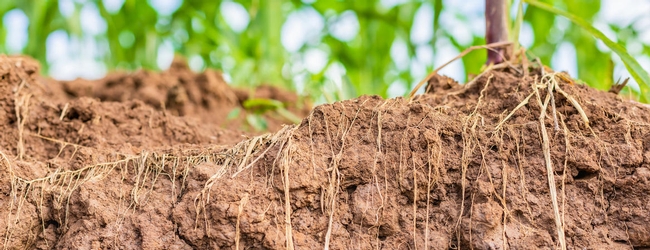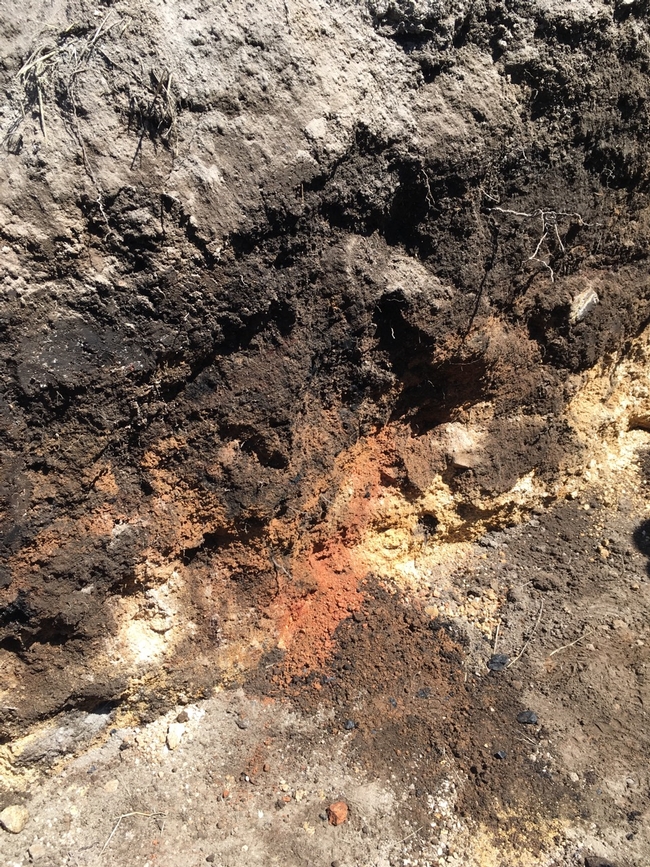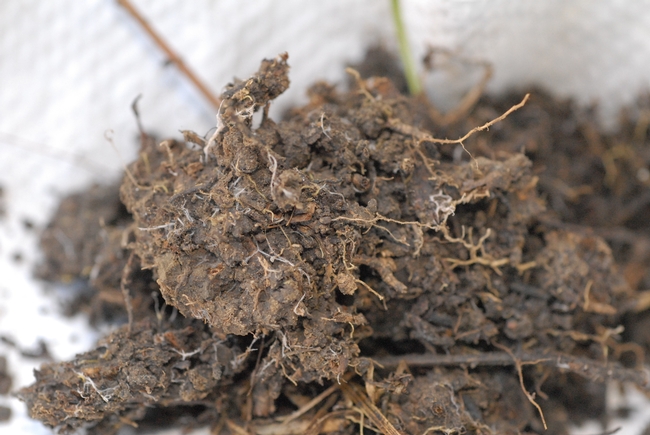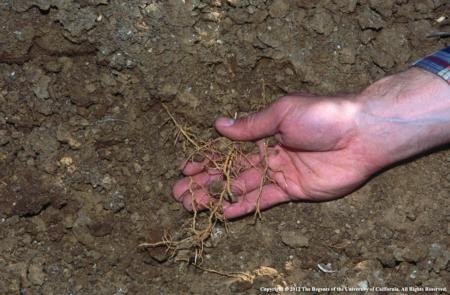- Author: Ben Faber
Under our feet, in the soil, is a wealth of microbial activity. Just like humans have different metabolisms and food choices, so do those microbes. In fact, microbes play an important role in making nutrients available to plants.
A recent review paper from Xinda Lu and his team looks at different roles that various soil microbes have in soil's nitrogen cycle. Lu is a researcher at Massachusetts Institute of Technology.
According to Lu, "Soil microbes catalyze most of the transformations of soil nitrogen into plant-usable forms. Diverse microbes use different processes - and sometimes work together. Knowing the various styles of soil microbes, and linking microbes to specific soil processes, can be important knowledge for farmers."
Modern nitrogen fertilizers are applied in the form of ammonium. Through a biological process called nitrification, soil microbes convert ammonium to nitrates that plants can absorb. In order to be efficient at this process, microbes need oxygen. Researchers are studying nitrification because it can be linked to greenhouse gases and loss of fertilizer.
Although microbiologists have been studying the nitrogen cycle for over a century, not all steps were well understood. New microorganisms have recently been identified. A type of prokaryote (single-celled organism) called archaea has also been playing a role in nitrification.
Archaea are not technically soil bacteria, due to their structure. These are newly a newly classified group that really do some amazing things. There are many more archaea that contribute to nitrification in some soils than there are bacteria responsible for the same activity. Including the role of archaea in nitrification has broadened the understanding of scientists and researchers.
Researchers reviewed various studies of soil nitrification. This included the abundance of microbes in soil in relation to various environmental factors. Soil pH, temperature and the ratio of soil carbon to soil nitrogen were all compared to the number of microbes in each soil sample. Soil depth and other factors also influence microbe abundance.
Previous studies have shown, for example, that nitrification archaea are more abundant than bacteria in warmer temperatures. Other microbes thrive in lower temperatures.
Soil pH also influences how active soil microbes are in the nitrification process. Soil bacteria Nitrospira were more dominant in acidic soils, including forests and farm fields.
Researchers have also studied how various microbes "talk" to each other. This keeps the nitrification process running smoothly. Various mechanisms have been proposed, including cell signaling. The presence of nitric oxide in soils may enhance interactions between microbes.
Soil scientists are sure they have not found all the microbes that contribute to the vast array of services soils provide. Just as astronomers discover new stars in the sky as tools advance, so will soil microbiologists find new soil microbes. Some may be involved in nitrification.
Collecting and cataloging the type, abundance and location of soil microbes will continue to advance the knowledge we have about the soil nitrogen cycle.
Crenarchaeota are involved with nitrification in the soil. Here's a cell of this group infected by virus STSV1 observed under microscopy.

- Author: Ben Faber
While domestication of plants has yielded bigger crops, the process has often had a negative effect on plant microbiomes, making domesticated plants more dependent on fertilizer and other soil amendments than their wild relatives.
In an effort to make crops more productive and sustainable, researchers recommend reintroduction of genes from the wild relatives of commercial crops that restore domesticated plants' ability to interact with beneficial soil microbes.
Thousands of years ago, people harvested small wild plants for food. Eventually, they selectively cultivated the largest ones until the plump cereals, legumes, and fruit we know today evolved. But through millennia of human tending, many cultivated plants lost some ability to interact with soil microbes that provide necessary nutrients. This has made some domesticated plants more dependent on fertilizer, one of the world's largest sources of nitrogen and phosphorous pollution and a product that consumes fossil fuels to produce.
"I was surprised how completely hidden these changes can be," said Joel Sachs, a professor of biology at UC Riverside and senior author of a paper published today in Trends in Ecology and Evolution. "We're so focused on above ground traits that we've been able to massively reshape plants while ignoring a suite of other characteristics and have inadvertently bred plants with degraded capacity to gain benefits from microbes."
Bacteria and fungi form intimate associations with plant roots that can dramatically improve plant growth. These microbes help break down soil elements like phosphorous and nitrogen that the plants absorb through their roots. The microbes also get resources from the plants in a mutually beneficial, or symbiotic, relationship. When fertilizer or other soil amendments make nutrients freely available, plants have less need to interact with microbes.
Sachs and first author Stephanie Porter of Washington State University, Vancouver, reviewed 120 studies of microbial symbiosis in plants and concluded that many types of domesticated plants show a degraded capacity to form symbiotic communities with soil microbes.
"The message of our paper is that domestication has hidden costs," Sachs said. "When plants are selected for a small handful of traits like making a bigger seed or faster growth, you can lose a lot of important traits relating to microbes along the way."
This evolutionary loss has turned into a loss for the environment as well.
Excess nitrogen and phosphorous from fertilizer can leach from fields into waterways, leading to algae overgrowth, low oxygen levels, and dead zones. Nitrogen oxide from fertilizer enters the atmosphere, contributing to air pollution. Fossil fuels are also consumed to manufacture fertilizers.
Some companies have begun selling nitrogen-fixing bacteria as soil amendments to make agriculture more sustainable, but Sachs said these amendments don't work well because some domesticated plants can no longer pick up those beneficial microbes from the soil.
"If we're going to fix these problems, we need to figure out which traits have been lost and which useful traits have been maintained in the wild relative," Sachs said. "Then breed the wild and domesticated together to recover those traits."

- Author: Ben Faber
Joint research conducted by The Nature Conservancy and the Kunming Institute of Botany, Chinese Academy of Sciences calculated the carbon-storing power of global soils and showcased approaches like agroforestry designed to capitalise on untapped potential.
A critical, nature-based approach to mitigating climate change has been right at our feet all along, according to a new study revealing that soil represents up 25% of the total global potential for natural climate solutions (NCS) – approaches that absorb CO2 from the atmosphere and lock it into landscapes, including forests, croplands and peatlands.
Representing the first time soil's total global potential for carbon-mitigation across forests, wetlands, agriculture and grasslands together has been catalogued, the study – led by scientists from The Nature Conservancy alongside Conservation International, Woods Hole Research Centre, University of Aberdeen, Yale University and the Kunming Institute of Botany, Chinese Academy of Sciences(KIB/CAS) – provided a timely reminder in this critical 'super year' for nature not to neglect the power of soils and the many benefits these ecosystems can deliver for climate, wildlife and agriculture.
Published in the journal Nature Sustainabilityentitled "The role of soil carbon in natural climate solutions". the research also argued that a lack of clarity to date regarding the full scale of this opportunity and how to best capitalise on it has restricted investment.
"While momentum continues to build behind the role nature can play in the global response to climate change, soils have historically enjoyed less of the limelight as a 'natural climate solution' compared with, say, forests or mangroves. Our study is designed to redress this situation," said lead author Dr. Deborah Bossio, The Nature Conservancy's Lead Soil Scientist. "By highlighting the full carbon-mitigation potential of soils across a range of landscapes, but also – crucially – exploring practical mechanisms that already exist for accelerating the uptake of these comparatively untapped approaches, including their integration into burgeoning carbon markets. This is particularly important for agriculture sector, for which more effective management of soils represents the single biggest contribution this industry can make towards mitigating climate change."
"Soils and improved soil management have a tremendous potential to store carbon. Agroforestry, and more generally just including more trees in the agricultural landscape, has been shown to be one of the most important approaches to increasing soil organic carbon with substantial global mitigation potential. In addition, highlighting the complimentary beneficial impacts available from improved agricultural production practices aimed at improving soil health, both the increased on-farm bio-diversity and livelihood diversification can enhance farm and ecosystem resilience," said co-author Dr. Robert Zomer of the KIB/CAS.
Demonstrating that soil carbon represents up to 25% of total global NCS potential, the paper also estimated that 40% of this potential will be delivered by protecting existing soil carbon reserves, while 60% will come from rebuilding stocks depleted by practices such as over-intensive arable agriculture and the draining of peatlands.
Breaking these data down further, the researchers also showed the share of total NCS potential that soil represents across various, climate-critical landscapes – from a relatively diminutive 9% of forest mitigation potential, through 47% for agricultural lands and grasslands, right up to 72% of total carbon sequestration potential in wetland landscapes.
The study also showed that agroforestry systems can have significant positive impacts on soil organic carbon across specific geographies. Moreover, the majority of other soil carbon pathways tend to be "no regrets" practices that deliver soil fertility, climate resilience and provide other ecosystem services alongside climate mitigation.
"We already know that nature has a powerful role in mitigating runaway climate change," said Prof. XU Jianchu from KIB/CAS, who was not associated with the study. “This study showed the NCS provide pathways for sustainable development that have both climate mitigation and livelihood improvement potential. It is essential that soil health become a central pillar of agricultural production, not just for climate mitigation, but also for both environmental and food security."

- Author: Linda Chalker-Scott
- Author: Jim Downer
Washington State University and UCCE Ventura County, respectively
Soils found in home gardens and public landscapes usually bear little resemblance to the original soil. Native soils are formed through centuries of interactions between climatic factors, local environmental factors, and the biological components of the soil. In contrast, soils found in developed areas are often distinctly layered, compacted, and artificially amended. Commercial topsoils, which are often called designed soils or landscape fill, bear little resemblance to natural topsoil as they generally contain abundant organic material and sand but relatively little topsoil. Unfortunately, many gardeners and landscape professionals are unaware of these differences and how they affect soil functionality and plant life. This lack of understanding, combined with popular soil management practices and products, can create soil conditions that are injurious to soil and plant life. In this article we deconstruct four common soil management myths and offer better methods to manage urban soils sustainably.
Most people with a personal or professional interest in gardens and landscapes are familiar with the soil triangle. The relative percentages of clay, silt and sand determine soil texture and function. Uncompacted sandy and silty soils are well drained, but nutrient poor; uncompacted clay soils are nutrient rich but have slow drainage. The perfect soil for growing plants is one that has adequate drainage and nutrient availability (Handrek and Black, 2002). Such soils are loams and contain mixtures of clay, silt and sand. Natural soils also contain organic matter around 1-6% of the total soil weight. Wetland soils, in contrast, have much higher levels of organic material. All of these natural soil types develop over centuries of interactions among climatic, geographic, environmental, and biological factors.
Read On:
Soil Myth Busting for Extension Educators: Reviewing the Literature on Soil Structure and Functionality

- Author: Ben Faber
Healthy Soils Workshop
February 19, 9am – 11am
University of California Cooperative Extension Office
669 County Square Drive Suite 100
Ventura, CA 93003
CDFA's Healthy Soils Program is opening and will be accepting applications on a rolling basis. Join us to learn about exciting changes to the grant opportunity, how to apply, and how to get technical assistance for your grant.
This event is free and open to anyone interested in soil health practices. Please share with your networks! We are also putting together a field day to discuss healthy soils practices in early March.
To RSVP and save your spot please follow the linkhttp://ucanr.edu/survey/survey.cfm?surveynumber=29382
**If you cannot attend but want to learn more, please contact
Alli at amfish@ucanr.edu for application questions and assistance or visit http://ciwr.ucanr.edu/Programs/ClimateSmartAg/ to locate a
technical assistance provider near you**




